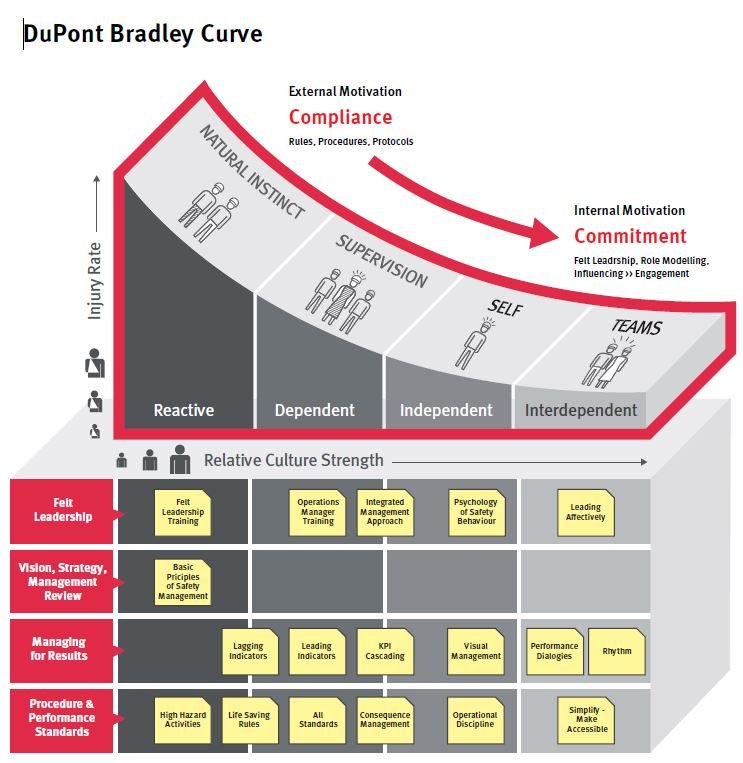Ask any senior manager if safety is important to the company and chances are the answer will be a clear “Yes”. However, understanding the strategic importance of safety and actually achieving it are not the same thing. As Martin Dean, Senior Manager, DuPont Sustainable Solutions, explains…

Behavioural safety management is an established part of the safety management repertoire, yet many companies are still struggling to implement it effectively. One of the main reasons why they are not getting the most out of it is that they think of it as a standard solution that can be applied universally and in all circumstances. The thinking is that if an operator is trained to follow the procedures, that will prevent any potential accidents he may face. But what happens, when the technology changes, a new work colleague joins the team, or the standard way of working has to be adjusted for a new product or new raw materials? Will that employee be independent enough to adapt to the new hazards or do they have to be retrained again and again? The answer will depend on the maturity levels of the company’s safety culture. In other words, an organisation that is trying to do just what’s legally required will have a completely different focus and different key performance indicators (KPIs) to one that is attempting to avoid subtle changes in risk. This is crucial, as key performance indicators drive employee behaviour. Set the wrong goals and you will get the wrong behaviours.
Getting all the KPI ducks in one row
So how do you know which KPIs are the right ones for your organisation? The secret is to understand and be honest with yourself about the maturity of your organisation’s safety culture. Is your organisation’s goal compliance with regulations and no more? Do your safety managers have to shoulder all the responsibility for safety? Do employees follow the rules only because they are worried about disciplinary action if they don’t? Or do they perhaps feel personal commitment to safety and see the value in it for themselves? Do they help others to conform?
There are different ways of getting an overview of your organisation’s current safety maturity. Of course, you can look at LTI rates and accident statistics, but that won’t give you the whole picture. Statistics indicate that a large number of businesses with a better than average Lost Time Injury (LTI) rate still suffer significant and even catastrophic incidents, for instance. These organisations appear to be tracking KPIs that lull them into a false sense of security and to be working on those KPIs in an ineffectual way. Clearly, an overview of LTI rates is not providing them with the information they need to make vital changes to safety behaviour in their organisation.
A methodical appraisal of key risks, risk awareness and behaviour of employees, differences between business units and hierarchies will provide some insights. Benchmarking the findings against other companies in the same industry will also give you an indication of the maturity level of your organisation compared to that of others.
In addition to recording lagging indicators such as accident statistics, organisations should also look at leading indicators e.g. supervisor activities that have a direct impact on the precursors to accidents. How do people in the organisation perceive risk? A survey of employees to find out how they feel about safety, what they think the organisation is doing right and wrong, etc. will reveal whether the organisation is aligned in pursuing the same safety goal or is out of sync.
With a good understanding of employee beliefs, as well as a clear grasp of safety weak spots in the organisation, areas where management and employees or different business units are not on the same page, it is possible to define what KPIs the entire organisation is ready for and can sign up to. Only then, can organisations decide which behaviours they need to drive and work on the gradual development of greater safety maturity throughout the organisation.
Methodologies for different levels of safety maturity
 Let’s say your company is still mainly focused on only avoiding fines for not complying with safety regulations or reducing lost time accidents. Employees react to hazards rather than anticipate them. Here, leadership engagement is key to moving the entire organisation forward. In other words, behavioural safety management needs to start at the top with senior managers leading by example. Behaviour safety management should focus on giving leaders the right skill set to model the correct behaviour in a highly visible way and communicate it effectively to the rest of the workforce. The focus will be on high hazard activities and lifesaving rules with employees needing to understand and absorb the basic principles of safety management. The behaviours that an organisation in this phase should be aiming to drive are visible leadership by management, persuasion and communication skills, and holding people accountable. Once this has been done, the organisation can gradually set out to achieve a better awareness of risks and their consequences.
Let’s say your company is still mainly focused on only avoiding fines for not complying with safety regulations or reducing lost time accidents. Employees react to hazards rather than anticipate them. Here, leadership engagement is key to moving the entire organisation forward. In other words, behavioural safety management needs to start at the top with senior managers leading by example. Behaviour safety management should focus on giving leaders the right skill set to model the correct behaviour in a highly visible way and communicate it effectively to the rest of the workforce. The focus will be on high hazard activities and lifesaving rules with employees needing to understand and absorb the basic principles of safety management. The behaviours that an organisation in this phase should be aiming to drive are visible leadership by management, persuasion and communication skills, and holding people accountable. Once this has been done, the organisation can gradually set out to achieve a better awareness of risks and their consequences.
Once an organisation has got to grips with the basics of behavioural safety management, it should no longer just track leading indicators such as accident rates. KPIs should now begin to address indicators that are activity based and the organisation should start working on consequence management. At this stage, employees’ behaviour is no longer reactive to situations, but is nonetheless still dependent and reliant on direction. Employees follow the rules under supervision and mainly out of fear of being disciplined, but at least, under guidance, they and the organisation plan for risks. As supervisors have frequent and direct contact with employees, they exert a huge influence on behaviour, can monitor safety compliance and set the tone with regard to attitudes to safety. Training should therefore focus on line and operations managers to equip them with the capabilities needed to manage behavioural safety directly.
In a more sophisticated safety culture in which employees see the value in safety, people follow the rules because they “get to” rather than they have “got to”. They see the benefit in doing so and look after their own safety. Their motivation is internal and no longer imposed by supervisors or regulations. At this stage, KPIs can be cascaded throughout the organisation as all levels understand that they are working towards the same common goal. Operational discipline still needs to be enforced, but management takes a more integrated, holistic approach to safety. While leadership must continue visibly to demonstrate its commitment to safety, it should start to consider the psychological reasons why people act in certain ways and what influences their behaviour. Behavioural safety management can begin to focus on subconscious decision making, to use nudges to prompt correct behaviour and look at ways of persuading people to break habitual patterns that are risky.
For organisations that have achieved the highest level of safety maturity, behavioural safety management continues to be valid and useful. Although employees at this level act interdependently and look out not just for themselves, but their teams, their engagement in safety needs to be maintained and kept fresh. Leaders should be working on appealing to employees emotionally and using affective communications to do so. Finding a way to humanise safety in an authentic, transparent manner can inspire employees to change behaviour much more effectively than a typical email or poster campaign. That requires quite different behavioural safety management skills than the management of employees who are at the other end of the safety culture maturity spectrum and expect safety managers to take care of their safety.
 Reaping the benefits of a mature safety culture
Reaping the benefits of a mature safety culture
DuPont Sustainable Solutions has been working with companies of all sizes in a wide variety of industries that are at different stages in their safety maturity development. Across the board, we have seen that behavioural safety management can achieve a paradigm shift in attitude among employees if it is driven by appropriate KPIs. The aim is to arrive at a point where employees behaviour focuses not just on compliance with rules, but where they are so engaged in the safety culture that they become self-improving, suggesting additional processes and systems that might help the company move forward. Such a shift in attitude is likely then also to affect other areas of operation such maintenance, quality, productivity in a positive way.
Why should you subscribe to the SHP newsletter?
Do you want the very latest health and safety news, product launches, job listings and expert opinions sent straight to your inbox daily?
The SHP newsletter is essential reading – sign up today to get your hands on all this!


 Let’s say your company is still mainly focused on only avoiding fines for not complying with safety regulations or reducing lost time accidents. Employees react to hazards rather than anticipate them. Here, leadership engagement is key to moving the entire organisation forward. In other words, behavioural safety management needs to start at the top with senior managers leading by example. Behaviour safety management should focus on giving leaders the right skill set to model the correct behaviour in a highly visible way and communicate it effectively to the rest of the workforce. The focus will be on high hazard activities and lifesaving rules with employees needing to understand and absorb the basic principles of safety management. The behaviours that an organisation in this phase should be aiming to drive are visible leadership by management, persuasion and communication skills, and holding people accountable. Once this has been done, the organisation can gradually set out to achieve a better awareness of risks and their consequences.
Let’s say your company is still mainly focused on only avoiding fines for not complying with safety regulations or reducing lost time accidents. Employees react to hazards rather than anticipate them. Here, leadership engagement is key to moving the entire organisation forward. In other words, behavioural safety management needs to start at the top with senior managers leading by example. Behaviour safety management should focus on giving leaders the right skill set to model the correct behaviour in a highly visible way and communicate it effectively to the rest of the workforce. The focus will be on high hazard activities and lifesaving rules with employees needing to understand and absorb the basic principles of safety management. The behaviours that an organisation in this phase should be aiming to drive are visible leadership by management, persuasion and communication skills, and holding people accountable. Once this has been done, the organisation can gradually set out to achieve a better awareness of risks and their consequences. Reaping the benefits of a mature safety culture
Reaping the benefits of a mature safety culture